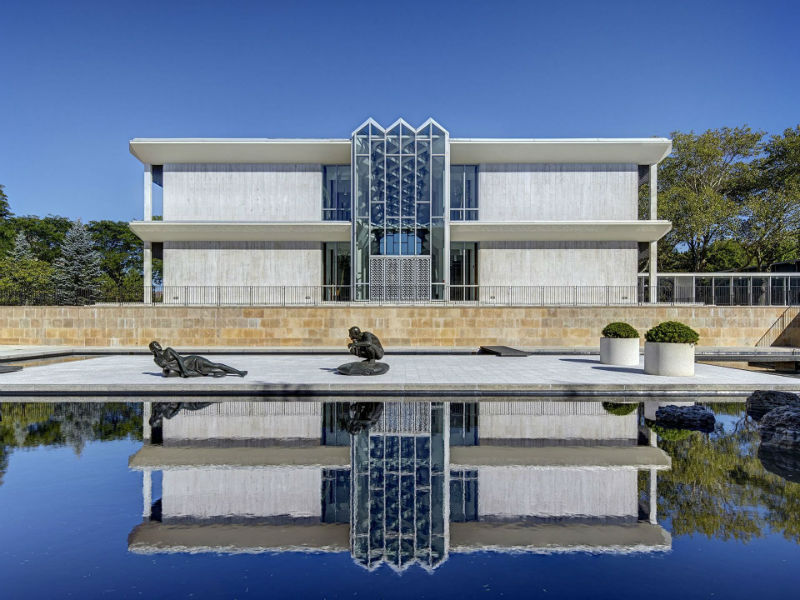Michigan’s extensive role in modern design among Kerrytown Bookfest highlights

If you don’t necessarily consider Michigan a hotbed of the modern design movement, you’re not alone. But two recent books aim to change that perception, and their authors will appear in Ann Arbor this weekend as part of the Kerrytown Bookfest.
“People do not think of Michigan as a design center," says Brian Conway, Michigan’s state historic preservation officer. "They think of New York or Los Angeles but skip over the Midwest. But there was this very strong design industry here in Michigan, and it actually still exists.”
This isn’t government boosterism or home-state pride. The Michigan Modern project -- which has included a website, exhibits, and symposiums in addition to the books -- makes a compelling case for Michigan’s leadership and importance in the movement.
The effort started about 10 years ago in the state Historic Preservation Office.
“We noticed a trend of buildings from the mid-century, which were now 50-60 years old, being undervalued, underappreciated, threatened, and in some cases demolished,” Conway explains. Researching those buildings led to an endless wealth of information about Michigan’s contributions to modern design, starting with industrial/commercial architecture, but also encompassing residential architecture, automobile design, furniture design, and design education.
“We got into the story, got into the research, and really uncovered the importance of Michigan’s role in the development of modernism,” Conway says. “I didn’t realize how deep and how rich it is, and how so many of the designers and the architects were working together.”
Crucially, Michigan had the automotive and furniture industries. But it also had the individual wealth and the educational institutions -- especially Cranbrook and the University of Michigan -- that allowed the movement to flower. “All of those things, combined, created a synergy that just didn’t exist anywhere else,” Conway says.

The early roots include Albert Kahn’s famous industrial building designs using reinforced concrete -- a breakthrough that allowed the old, timber-and-brick model of factories to be replaced by something much more clean, open, and larger.
“That quickly became the model of choice for automobile manufacturing,” Conway says. “The whole world was looking at what was happening in Detroit.” In fact, leading European architects and other pioneers of modernism came to Michigan to study and write about what was happening here. “They took that factory aesthetic and applied it to other residential and commercial buildings,” Conway says.
Meanwhile, Cranbrook, founded in 1904 in Bloomfield Hills, quickly gained influence and is often considered the cradle of modernism, Conway notes. Michigan also played a role in the Midwest movement toward more organic residential architecture, with buildings designed by people like Frank Lloyd Wright and Minoru Yamasaki, as well as important homegrown architects like Alden B. Dow.
Ann Arbor plays an important part in the story, particularly the architectural aspects.
“The University of Michigan in Ann Arbor was one of the first architectural programs in the country to start teaching the philosophy of modern design,” says Conway, who earned his own undergraduate degree from the Taubman College of Architecture and Urban Planning. “The first dean, Emil Lorch, was a proponent of the theory of pure design, which was very influential in early modern art. It was based on geometric forms and colors, not based on any historical, decorative kind of ornamentation.
“He applied that theory to the curriculum at the University of Michigan. … Those architecture students were looking at architecture from a different point of view. Other universities at that time were still promoting beaux-arts classicism.”
The influence of the U-M architecture school extended well beyond campus, however, Conway says: “As Ann Arbor developed, many of the people associated with the university, and others in the community, turned to the faculty, who had practices on the side, to design houses for them. So you have neighborhoods like Ann Arbor Hills and others that are almost museums of modern residential architecture.”
In 2016, Conway and Amy L. Arnold published Michigan Modern: Design That Shaped America, an eye-popping and eye-opening work that details Michigan’s many contributions to the movement. This spring, Conway and photographer James Haefner released Michigan Modern: An Architectural Legacy, which highlights some of the state’s stunning modern buildings with spectacular photography.
Conway and Arnold will appear at a presentation Sunday as part of the annual Kerrytown Bookfest. The annual one-day festival features a variety of exhibitors and a children’s tent as well as a full schedule of presentations and discussions on topics including women in literature, urban realism and fiction, and books about the Flint water crisis and Detroit hockey.
Bob Needham is a freelance writer and the former arts & entertainment editor of The Ann Arbor News and AnnArbor.com.
The Kerrytown Bookfest takes place 10:30 a.m.-5 p.m. Sunday, Sept. 9 at the Ann Arbor Farmers Market and Kerrytown Concert House. Admission is free. The panel “Modern Michigan Architecture - Design and Legacy” takes place at 1:15 pm at Kerrytown Concert House. An opening reception takes place Saturday evening at the Ann Arbor District Library. Find more information about the event on the festival website or its Facebook page.


































